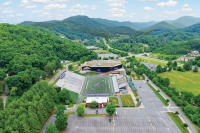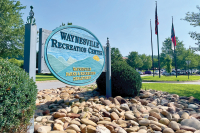One park at a time: WNC hiker explores the South’s natural and human history through national parks
 For Danny Bernstein and her husband Lenny, trips south to visit Lenny’s family in Miami Beach are a regular feature of life. They always drive rather than fly, and it didn’t take long to realize that the route brushes near an awful lot of national park units. The couple’s travel routine soon began to include two park visits with each trip — one on the way south and one on the return trip north.
For Danny Bernstein and her husband Lenny, trips south to visit Lenny’s family in Miami Beach are a regular feature of life. They always drive rather than fly, and it didn’t take long to realize that the route brushes near an awful lot of national park units. The couple’s travel routine soon began to include two park visits with each trip — one on the way south and one on the return trip north.
“As I really dug into it, this was not in and out,” said Danny Bernstein, who lives in Asheville. “It was, we’re going to spend a day and we’re going to do this.”
The trips were fascinating to Bernstein, an avid hiker who’s done all trails in the Great Smoky Mountains National Park and hiked the Mountains-to-Sea Trail across the state of North Carolina. She’s a fan of nature, but she also found the stories encapsulated in the parks to be enthralling and the rangers there to tell them more than willing to the spend the time necessary to tell the whole story. So what if, she began to think, she expanded the project to visit each and every National Park unit in the South? What if she wrote a book about it?
The result was Forests, Alligators, Battlefields: My Journey through the National Parks of the South, a book set to come out March 15. Writing it required visiting all 71 of the national park units in the region the National Park Service defines as the Southeast. The region includes Kentucky to the north, Louisiana to the west, the U.S. Virgin Islands to the south and the Atlantic Ocean to the east. In addition to actual national parks, of which there are seven within those boundaries, the book includes all the battlefields, monuments, historical parks, military parks, seashores, preserves and historical trails the Park Service manages. They range in size from little postage stamps of an acre all the way up to the 816 square miles of the Great Smoky Mountains National Park.
But they’re all important, Bernstein said.
“They are a public history. They preserve our public history and culture,” she said of the parks as a whole. “That in itself makes it very valuable, and they also preserve a tremendous amount of land that nobody else would preserve.”
Related Items
It was a realization that gathered strength as she visited sites as diverse as Mammoth Caves National Park in Kentucky and the home of freed slave William Johnson in Mississippi’s Natchez National Historical Park. Parks become parks for all sorts of reasons, each explained through that park’s unique history.
“It’s not that easy to become a national park,” Bernstein said. “You have to have a lot of local support. You have to have enough documentation to say something real happened here, and obviously whoever owns the land has to be willing to sell it, so it’s interesting as to what makes it a park.”
Meeting the story-keepers
Fortunately, Bernstein found plenty of help in understanding the history from the rangers she encountered at each place. One of her biggest takeaways from the experience, she said, was just a better appreciation for the people charged with telling the national parks’ stories.
One of her favorites was Dan Luther, a career actor who now plays President Andrew Johnson in various reenactments at Andrew Johnson National Historical Site in Greenville, Tennessee. Most famous as the only president to be successfully impeached, Johnson was a “third-rate” president, Bernstein said, but Luther gave her an appreciation for who he was outside of his failed presidency.
“The Historical Society came here and said, ‘We are being too nice to Johnson,’” Bernstein recalled Luther telling her. “But you know, you live with the guy day in and day out.”
“After eight hours,” Bernstein said, “I liked him myself.”
Barney Schoby, a ranger at Nachez National Historical Park, delivered yet another memorable moment. The park celebrates William Johnson, a black man living during slavery who, after being freed, went on to meet a substantial degree of success as a barbershop owner.
“I start talking to him (Schoby) about William Johnson and he’s testing me,” Bernstein said. “He said he (Williams) had all his children baptized in the New Orleans cathedral as Catholics even though he wasn’t Catholic. Now why do you think that was?”
The answer turned out to be rather revealing of the times in which Johnson lived. One thing the Catholic Church does quite well, Schoby said, is keep records. Baptized as Catholics, it would be easy for Johnson’s children to prove their freedman’s status to anyone who questioned it.
It’s those kinds of anecdotes that animate seemingly stagnant sites like battlefields and historic homes.
“It’s only with a story with people that it all becomes alive,” Bernstein said.
Exploring the outdoors
A country whose allure — even before its modern history began — has long been rooted in its wildness, America’s national parks also reflect its natural treasures. Anyone who’s set foot in the Great Smoky Mountains National Park, the largest national park unit in the eastern U.S., can attest to why that’s important. And while Bernstein is quick to say that the Smokies, as her “home park,” are a rather impossible act to beat — on all the visits she did to other parks while researching the park, she wore a Smokies T-shirt to demonstrate her true allegiance — there’s some pretty dazzling beauty in the South’s other natural wonders as well.
“It’s a completely different beauty than we have here,” she said.
On some of those excursions, Bernstein had her grandchildren in tow, the youngest of whom was about 4 at the time.
On one of these outings, they had visited a zoo before hitting the park.
“In the zoo everything is labeled. Everything is there,” Bernstein said. “I was really worried. Now we gotta got to a park, we gotta find these things, and we gotta figure out what they are. How can that top a zoo? Well, the zoo was completely forgotten.”
The kids loved it, running around and asking whether this, that or the other thing was real or fake. It was all real, she assured them.
She had a similar experience when visiting Canaveral National Seashore, also with the kids. The trip piggybacked on a trip to Disney World. The seashore portion turned out to be a huge success, and not just because the $4 entrance fee was much, much lower than tickets to the amusement park.
“When you have egrets and herons that are right there, even kids are wowed,” Bernstein said.
The next 100 years
Compared to Disney World, the seashore was blessedly quiet and unpeopled. Despite all the talk of skyrocketing visitation, of national parks being “loved to death” and crowded roads and trails, Bernstein said, her experience suggested otherwise.
“Many of these places, I was there by myself,” she said. “I felt like they had opened the park for me.”
“Even the Smokies,” she added, “if you get off a mile or two off the asphalt you’ll see almost no one.”
That said, with the National Park Service kicking off its celebration of 100 years in existence this month, Bernstein said she’s hopeful for the future of the national parks. From her perspective, people are using them, and they’re by no means maxed out.
And yes, America’s population is becoming increasingly urban, but that’s not necessarily cause for concern either. After all, Bernstein herself is a Brooklyn girl.
“You know, Brooklyn, New York, close to that one tree that doesn’t exist,” she joked. Her childhood didn’t involve a lot in the way out outdoor exploration.
“People grow up. People change,” she said. “The fact that your parents didn’t take you to a national park when you were 10 doesn’t mean you won’t go when you’re 40, when you have your own car, your own money.”
But however many years it is before a person discovers the national parks and all they have to offer, Bernstein said, there’s plenty to explore and plenty to learn, maybe without even having to drive too terribly far.
And the best part is, it’s open to everyone.
“I didn’t have anything that anybody else didn’t have in terms of access to people, information,” Bernstein said. “There are no secrets. You just have to spend the time reading, talking to people and walking.”
Celebrate the centennial
On Aug. 25, 1916, President Woodrow Wilson signed a bill into law that created the National Park Service. This year marks the passage of 100 years since that date, and the Park Service is taking full advantage of the opportunity for celebration.
Hoping to kick off a second century of stewardship of America’s most precious natural and cultural gems, the Park Service’s centennial year will feature a variety of events and initiatives aimed at carrying engagement in the national parks over to the next generation.
Besides the Great Smoky Mountains National Park, Park Service units in Western North Carolina include the Blue Ridge Parkway, the Appalachian Trail and the Carl Sandburg Home National Historic site.
Centennial events in park units across the nation are listed at www.findyourpark.com.
Get the book
A book chronicling Danny Bernstein’s adventures and insights from visiting each of the 71 national park units in the Southeast — Forests, Alligators, Battlefields: My Journey through the National Parks of the South — is available for preorder.
Leading up to the book’s March 15 publication, Bernstein is looking for groups such as hiking clubs, nature centers and historical societies who would like her to come present.
An Asheville-based hiker, author and blogger, Bernstein leads monthly hikes in the Great Smoky Mountains National Park through Friends of the Smokies and is active in the Carolina Mountain Club. She has hiked the entire Mountains-to-Sea Trail and all designated trails in the national park.
Preorder at www.hikertohiker.net.









